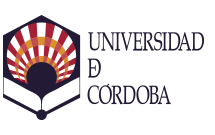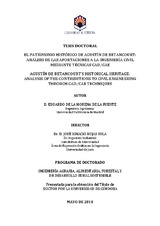El patrimonio histórico de Agustín de Betancourt: análisis de las aportaciones a la ingeniería civil mediante técnicas CAD/CAE
Agustín de Betancourt’s historical heritage: analysis of the contributions to civil engineering through CAD/CAE techniques
Autor
Morena de la Fuente, Eduardo de la
Director/es
Rojas-Sola, José IgnacioEditor
Universidad de Córdoba, UCOPressFecha
2018Materia
Betancourt, Agustín de 1758-1824Ingeniería gráfica
Historia de la tecnología
Diseño asistido por ordenador
Ingeniería asistida por ordenador
Patrimonio histórico
Arqueología industrial
Engineering graphics
History of technology
Computer-aided design
Computer-aided engineering
Historical heritage
Industrial archaeology
METS:
Mostrar el registro METSPREMIS:
Mostrar el registro PREMISMetadatos
Mostrar el registro completo del ítemResumen
las aportaciones más importantes de Agustín de Betancourt y Molina relacionadas con la
ingeniería civil desde el punto de vista de la ingeniería gráfica.
Su contenido se estructura en los siguientes capítulos:
El Capítulo 1 expone una aproximación a la figura y obra del genial ingeniero español. Se hace
un recorrido somero por su biografía incidiendo en su formación, en las personas que influyeron
en ella y en los principales trabajos que llevó a cabo. Asimismo, se ha realizado un especial
esfuerzo en ordenar cronológicamente su obra científica y técnica, resaltando aquellas
contribuciones cuyo aporte a la ingeniería civil ha sido mayor.
El Capítulo 2 se centra en exponer los materiales y el marco teórico de la metodología aplicada
para conseguir los objetivos de la tesis doctoral. En primer lugar, se ha detallado el proceso de
diseño asistido por ordenador de cualquier invención ligada al patrimonio histórico técnico
desde el material de partida hasta modelo CAD 3D, utilizando para ello, el software Autodesk
Inventor Professional 2016 y su herramienta de animación Autodesk Inventor Studio. En
segundo lugar, se ha descrito el proceso para la impresión 3D de los modelos estudiados
utilizando técnicas de fabricación aditiva. Y en tercer lugar, se ha descrito el proceso de análisis
de ingeniería asistida por ordenador (CAE) en orden a realizar el análisis estático de cada una de
las invenciones históricas analizadas, utilizando el método de elementos finitos.
El Capítulo 3 presenta los resultados obtenidos al aplicar la metodología descrita en el capítulo
2 sobre las 5 aportaciones más notables de Agustín de Betancourt y Molina, relacionadas con la
ingeniería civil: la máquina eólica para desaguar terrenos pantanosos, la máquina para cortar las
cañas y otras plantas acuáticas en canales y ríos navegables, el molino de accionamiento
hidráulico para la molienda del sílex, la esclusa émbolo buzo y la draga mecánica del puerto de
Kronstadt. El estudio independiente de cada uno de las invenciones, ha posibilitado obtener un
modelo 3D ensamblado y funcional, así como una impresión 3D y un completo estudio de
tensiones de von Mises, desplazamientos, deformaciones y coeficiente de seguridad. Así pues, a
partir de estos resultados se han obtenido unas conclusiones desde el punto de vista de la
ingeniería mecánica y de la ingeniería constructiva.
Por último, en el Capítulo 4 se exponen las conclusiones generales, particulares y posibles
desarrollos futuros que se desprenden a partir de la presente tesis doctoral. Las conclusiones
generales apuntan a la relevancia del trabajo de Agustín de Betancourt y Molina en la ingeniería
de la época y en la ingeniería actual, así también sobre la conveniencia y limitaciones de la
metodología seguida para el estudio de las invenciones históricas. Por su parte, las conclusiones
particulares hacen hincapié en las aportaciones específicas a la ingeniería que hacen cada uno de
los ingenios, y finalmente, se proponen tres líneas de investigación para estudios ulteriores en el
campo del patrimonio histórico técnico. The present doctoral thesis develops an innovating and original research about some of the
most important contributions of Agustín de Betancourt y Molina related to civil engineering
from the point of view of engineering graphics. Its content is divided into the following chapters:
Chapter 1 shows an approach to the person and work of the outstanding Spanish engineer.
There is a short journey through his biography, focusing on his education, on the people who
influenced him and on the main works he carried out. Also, a special effort has been made to
order its scientific and technical work chronologically, underlining those whose contribution to
civil engineering has been important.
Chapter 2 focuses on exposing the materials and the theoretical framework of the methodology
applied to achieve the objectives of the doctoral thesis. Firstly, the process of computer-aided
design of any invention linked to the technical historical heritage, from the starting material to
the 3D CAD model has been detailed, using Autodesk Inventor Professional 2016 software and
Autodesk Inventor Studio animation tool. Secondly, the process for 3D printing of the models
studied using additive manufacturing techniques has been described. And third, the process of
computer-aided engineering (CAE) analysis has been described in order to perform the static
analysis of each of the historical inventions, using the finite element method.
Chapter 3 presents the results obtained by applying the methodology described in chapter 2 on
the five most notable contributions of Agustín de Betancourt y Molina related to civil
engineering: the wind machine for draining marshy ground, the machine for cutting cane and
other aquatic plants in navigable waterways, the hydraulic drive mill for flint milling, the
plunger lock and the mechanical dredger in the Port of Kronstadt. The independent study of
each invention has made possible to obtain an assembled and functional 3D model, as well as 3D
printing and a complete study of von Mises stresses, displacements, deformations, and safety
coefficient. Thus, from these results some conclusions have been obtained from the point of view
of mechanical and construction engineering.
Finally, Chapter 4 presents the general and particular conclusions and possible future works
that arise from the present doctoral thesis. The general conclusions point to the relevance of the
work of Agustín de Betancourt y Molina in the engineering of the time and in the current
engineering, as well as the convenience and limitations of the methodology followed in the study
of the historical inventions. On the other hand, the particular conclusions emphasize the specific
contributions to engineering made by each one of the inventions, and at last, three lines of
research are proposed for additional studies in the field of technical historical heritage.

